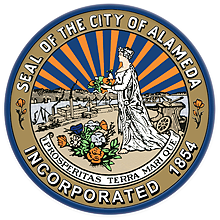Frequently Asked Questions
Revised October 17, 2018
1. Has an application been submitted for development of the approximately 3.65 acre site along McKay Avenue that is being surplused by the federal government (“Project Site”)?
Yes. On April 19, 2018, Alameda Point Collaborative (“APC”) submitted a Planning Permit Application to remove the Special Government Combining District (G) Overlay and revise the General Plan designation for the Project Site from Federal Facilities to Office to be consistent with the underlying zoning for the Project Site.
2. Who owns the Project Site now and what legal rights does APC have to the site?
The federal government owns the Project Site. In December 2017, the U.S. Department of Health & Human Services (“HHS”) conditionally agreed to convey the Project Site to APC for assisted living, medical respite, and supportive service facilities for the homeless. HHS’ conditional approval can be found on APC’s project website, www.caringalameda.org.
On September 26, 2018, APC entered into a 3-year lease for the Project Site with HHS. The lease will convert to a deed of trust after the City Council approves the Planning Permit Application described above. APC has insured the Project Site and entered into contracts with Serpico Landscaping for groundskeeping services, and with Security Systems Management for onsite security services. Qualified APC staff will handle other maintenance aspects to keep the site viable as predevelopment activities begin.
3. Does the City have a copy of APC’s application to HHS? Are there binding actions that the project must fulfill or a required scope in APC’s application to HHS?
The City does not have a copy of APC’s application to HHS. Based on a letter from HHS to APC dated December 13, 2017, conveyance of the Project Site is subject to certain conditions, including removal of the Special Government Combining District (G) Overlay and submittal of an Environmental Assessment (“EA”) pursuant to the National Environmental Policy Act. On June 13, 2018, HHS notified APC that it issued a Finding of No Significant Impact concerning APC’s approved use of the property based on its review of the EA. The EA and EA Appendices can be found on APC’s project website, www.caringalameda.org.
4. Does APC need the G overlay removed to take title to the Project Site? Does the federal government need the overlay removed to transfer title to APC?
Based on a letter from HHS to APC dated December 13, 2017, APC must provide evidence to HHS that the Special Government Combining District (G) Overlay has been officially removed before the Project Site can be conveyed by Quitclaim Deed.
5. Is APC proposing a homeless shelter, an emergency shelter, or a “warming shelter” on the Project Site?
No. APC is not proposing any type of shelter or temporary residence for homeless individuals and/or families on the Project Site.
6. What is APC proposing on the Project Site?
APC proposes to develop the Project Site as a recuperative care and senior housing facility with medical services as well as a resource center for Alamedans who are at risk for homelessness or newly homeless. The proposed uses include:
A 90-unit facility to provide housing and general care for highly vulnerable homeless elders with complex medical conditions;
A 50-bed medical respite center for the recuperative care of homeless convalescing patients with medically complex conditions departing from hospitals or undergoing intensive medical treatment;
A 7,000 square foot Primary Care Health Clinic providing on-site medical and mental health care for residents and clients of the recuperative care and senior housing facilities; and
A Resource Center with offices for case workers and outreach workers to meet with clients.
In July 2018, APC secured Mercy Housing as a development partner for the project. In August 2018, the Alameda County Board of Supervisors approved an initial allocation of $690,000 for early development activities for the project. The funds will be used for design, legal costs, and site viability as the project moves forward. In September 2018, APC and Mercy Housing issued a Request for Qualifications for architectural design of the Project Site. More information can be found on APC’s project website, www.caringalameda.org.
7. Didn’t Measure WW Require EBRPD to Acquire the Project Site?
No. Bond Measure WW was a 2008 ballot measure that authorized the East Bay Regional Park District to issue and sell up to $500,000,000 in bonds to complete the East Bay Regional Park District Master Plan for parklands and open space. Measure WW identified funds for the acquisition and development of surplus federal property adjacent to Crab Cove to expand and improve Crown Beach. An excerpt from the Sample Ballot can be found below:

8. Wasn’t the Project Site rezoned to Open Space in 2014?
No. In 2014, the proponents of the “Initiative for Expansion of Open Space at Crab Cove” circulated and qualified an initiative to rezone a 3.899-acre parcel of surplus federal property (“EBRPD Site”) to Open Space. The property was bounded by multi-family residential uses to the west, federal office and research buildings utilized by the U.S. Department of Agriculture to the north, an EBRPD visitor center and parking lot to the east, and an EBRPD maintenance facility (corporation yard) and building called “Glory of the Seas” to the south. The EBRPD Site was improved with two federal office buildings and a parking lot, and subsequently conveyed to the East Bay Regional Park District (“EBRPD”).
On July 1, 2014, the City Council adopted Ordinance No. 3102 approving the rezoning rather than placing the initiative on the ballot. The only property that the ordinance rezoned to Open Space was the EBRPD Site. No other land in the City was affected.
9. What is the Settlement Agreement that everyone is referring to?
On October 21, 2015, the federal government, the State of California, and EBRPD entered into an agreement to resolve disputes arising out of the federal government’s filing of a Declaration of Taking for the parcel known as McKay Avenue and an adjoining sidewalk easement (“Settlement Agreement”). The City of Alameda is not a party to the Settlement Agreement.
10. Does the Settlement Agreement address the EBRPD Site and the Project Site?
Yes. The Settlement Agreement addresses both sites, but refers to the EBRPD Site as “Neptune Pointe” and the Project Site as the “Retained Parcel.” The Settlement Agreement describes the transfer of Neptune Pointe from the federal government to EBRPD and specifies that the federal government will continue to own and operate the Retained Parcel, a separate legal parcel created on November 9, 2015.
Section 5 of the Settlement Agreement states the following:
The Retained Parcel may be subdivided and fully developed in the future;
EBRPD and State Parks will not interfere, legally or otherwise, with the use or transfer of any portion of the Retained Parcel, including any use consistent with the neighboring area by a private purchaser;
EBRPD and State Parks shall not participate in or seek to influence any change of zoning for the Retained Parcel as long as the parcel is owned by the United States or a direct purchaser from the United States; and
EBRPD and State Parks will not oppose a project of a Direct Purchaser of the Retained Parcel on a wholesale basis.
11. Is the Project Site zoned as Open Space?
No. The Project Site is not zoned as Open Space.
12. What is the zoning designation for the Project Site?
The Project Site is zoned Administrative Professional (A-P), which is applied to areas where administrative and professional offices, and medical and related facilities are the proper uses.
Because the Project Site is currently owned by the federal government, its General Plan land use classification is Federal Facilities and its zoning designation includes a Special Government Combining District (G) Overlay, which indicates that the land is owned by the federal government.
13. What uses are permitted in the Administrative Professional (A-P) zone?
The following uses are permitted at sites that are designated Administrative Professional (A-P): administrative and professional offices, medical facilities (including, but not limited to dental clinics, hospitals, medical clinics, medical laboratories, nursing and convalescent homes, radiologist labs, rest homes, and sanitariums), and incidental or accessory buildings. (Alameda Municipal Code, § 30-4.7.)
14. Does the City have authority or power to impose conditions on APC’s operations, as under a use permit?
Any proposed uses consistent with the underlying zoning are permitted uses, and do not require approval of a discretionary permit such as a Conditional Use Permit. Where a discretionary permit is not required, the City does not have the discretion to impose conditions of approval. All uses, however, must be consistent with relevant provisions of the Alameda Municipal Code, the California Building Standards Code, as amended by the City of Alameda, the California Fire Code, as amended by the City of Alameda, and all other applicable federal, state and local laws and regulations.
15. What is the order of City review and approval steps, including Planning Board and City Council actions?
On October 8, 2018, the City Planning Board conducted a public hearing and approved a resolution recommending City Council approval of APC’s application to remove the Special Government Combining District (G) Overlay and amend the General Plan designation for the Project Site from Federal Facilities to Office. The Planning Board also recommended City Council adoption of the Mitigated Negative Declaration for the project.
On December 4, 2018, the City Council will conduct a public hearing and consider approval of APC’s application. To amend the General Plan Land Use Diagram and text, the City Council must adopt a resolution, which requires three votes and only one reading. To amend the Zoning Map to remove the Special Government Combining District (G) Overlay, the City Council must adopt an ordinance, which requires three votes and two readings.
The proposed project will return to the Planning Board in the future for consideration of a Development Plan and Design Review. Both actions will require Planning Board approval, which is a final determination unless appealed or called for review.
16. Are there any State licenses required to operate this facility?
The Alameda Senior Housing and Medical Respite Center proposes senior permanent supportive housing, medical respite, a resource center, and a primary care clinic. There are a number of state laws that apply to the licensing, operation and management of such facilities. Although the City does not have adequate information at this time to know what licenses will be required, APC has informed the City that the primary care clinic will require state licensing, the licensing requirement for assisted living will depend on the level of medical support provided, and the respite care will not require state licensing.






